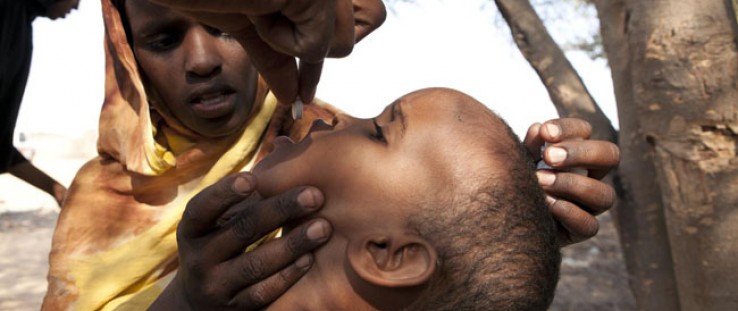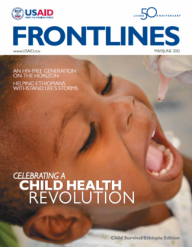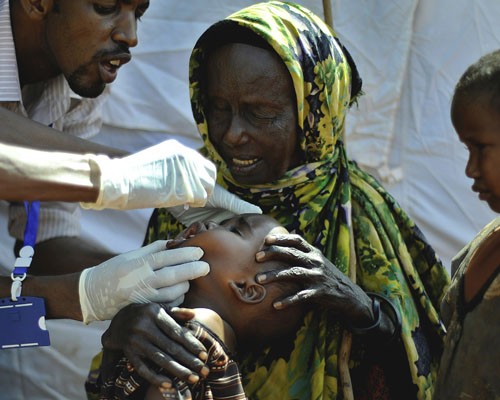 On July 29, 2011, a girl receives a de-worming tablet in the village of Malayley, about 30 kilometers from the northeastern town of Dadaab, Kenya. It is the last day of a large-scale UNICEF-supported immunization campaign under way in the area.
© UNICEF/NYHQ2011-1217/MODOLA
On July 29, 2011, a girl receives a de-worming tablet in the village of Malayley, about 30 kilometers from the northeastern town of Dadaab, Kenya. It is the last day of a large-scale UNICEF-supported immunization campaign under way in the area.
© UNICEF/NYHQ2011-1217/MODOLA
 On July 29, 2011, a girl receives a de-worming tablet in the village of Malayley, about 30 kilometers from the northeastern town of Dadaab, Kenya. It is the last day of a large-scale UNICEF-supported immunization campaign under way in the area.
© UNICEF/NYHQ2011-1217/MODOLA
On July 29, 2011, a girl receives a de-worming tablet in the village of Malayley, about 30 kilometers from the northeastern town of Dadaab, Kenya. It is the last day of a large-scale UNICEF-supported immunization campaign under way in the area.
© UNICEF/NYHQ2011-1217/MODOLA
From the time they are born until the age of 6, most children receive a long list of vaccines to protect them from debilitating illnesses.
The routine shots are even more important, physicians and development experts say, for young children caught in the grip of a crisis—be it an earthquake in Haiti, a coup in Côte d’Ivoire, once-in-a-century flooding in Pakistan or, as was the case last year in the Horn of Africa, a brutal drought that sent them and their parents searching for food.
“Malnourished children are more susceptible to disease, and when they do get sick, they are more likely to suffer severe consequences, which can lead to higher death rates,” says Murray Trostle, the senior immunization coordinator for the Bureau for Global Health’s Office of Health, Infectious Diseases and Nutrition.
Vaccination helps to stop that train wreck in its tracks, working to prevent children from becoming ill in the first place. “And given the crowded conditions in many [refugee] camps, if a communicable disease does get started, it will spread very quickly. Vaccination can slow this spread and protect many children,” says Trostle.
When USAID responds to any emergency around the world, vaccination campaigns are a core component of services provided on the scene if an assessment team concludes immunizations are necessary. The Office of U.S. Foreign Disaster Assistance (OFDA) works in tandem with the World Health Organization and UNICEF to insure that vaccine supplies are distributed to wherever they are needed. The arsenal in this fight against the spread of disease contains vaccines that are targeted on diseases that have serious outbreaks in emergency situations, like measles.
So when a measles outbreak hit camps in Kenya late last year, USAID was ready, says Dr. Priya Shete, a public health adviser in OFDA. Both children and adults were coming into makeshift health clinics with the telltale signs of measles, so protocols were adjusted to vaccinate not only children, but adults up to age 26. Usually children are the primary targets of such campaigns.
“In this context where adults and children are affected, it made more sense to build immunity in everyone,” Dr. Shete says. “We curb the spread of measles not only in the camps, but also in host communities.”
In addition to the measles vaccines, children in the camps received other routine immunizations. Most of their parents fled their homes without any record of prior immunizations for the children, which can complicate vaccine campaigns.
“I think what made the Horn of Africa response a little bit trickier than other responses is we were talking about three countries with significantly different capacities, different baseline immunizations rates,” Dr. Shete explains.
Kenya, for instance, has a relatively stronger record for childhood immunizations. But children who fled from Somalia, which is extremely isolated, could be expected to have received few of the shots that appear on the childhood immunization schedule. And Ethiopia has been more of a mixed bag when it comes to immunizing children.
“In a humanitarian crisis, really, the key elements are to prevent those diseases that tend to surge in that crisis setting,” Dr. Shete says. “Measles is a big one for us.”
Pooled Funds
USAID funding for the emergency vaccination campaign was pooled with donations from other countries and organizations by UNICEF, which conducted the on-the-ground vaccinations alongside various NGO partners.
Between September and December 2011, UNICEF reported providing measles vaccinations to 5.9 million children in Ethiopia between ages six months and 15—or 96 percent of the target population. It vaccinated nearly 200,000 children alone in the Afar region of the country. In Somalia, over a slightly different time period—between July and October—humanitarian agencies immunized just over a million children for measles in eight regions in the south and central parts of the country. And in Kenya’s Nyanza and Rift Valley, nearly 1.2 million children received vaccinations for polio during a four-day push in late September.
“It’s definitely a success just by looking at the number of children we reached with our partners,” Dr. Shete says. Workers vaccinated nearly everyone they targeted in Ethiopia and Kenya. However, for Somalia, the vaccination numbers represent 44 percent of the children health workers had wanted to immunize. Here and in some other countries cultural factors and security concerns can come into play and prevent USAID and other organizations from reaching every child with vaccines.
Every parent should receive a health card that notes their child’s vaccinations, and should be instructed on when booster shots are necessary and how to determine if there are any adverse side effects to the shots.
At the first pledging conference for the Global Alliance for Vaccines and Immunization (GAVI) in June 2011, donors committed $4.3 billion. The funding will immunize more than 250 million of the world’s poorest children against life-threatening diseases by 2015, and prevent more than 4 million premature deaths. USAID Administrator Rajiv Shah announced a $450 million commitment from the United States over three years, which is subject to congressional appropriation. With the pledge, the United States surpassed $1 billion in commitments to GAVI for the purchase of vaccines since 2000.
The United States has played a lead role in GAVI since its inception, and is a world leader in support of every aspect of the vaccines value chain, including research, development, affordability, delivery systems and policy coordination.
The vaccines are considered safe for children even in their weakened states.
“Malnutrition is not a reason for not vaccinating a child,” Trostle says. “However, caution needs to be taken with some new vaccines as we do not have significant experience with the vaccine and malnourished populations.”
The short-lived measles outbreak likely indicates that children did not receive measles vaccinations in their hometowns. If not for the Horn campaign, some children may never have received their childhood vaccinations.
“It’s hard to say for sure, but I suspect that many of them would not have received the complete primary series of vaccinations,” Trostle says. “Since most do not have vaccination records, we really have no way of knowing.”










Comment
Make a general inquiry or suggest an improvement.